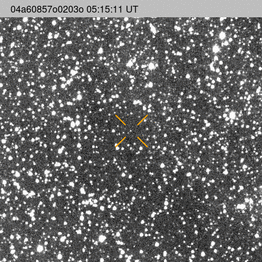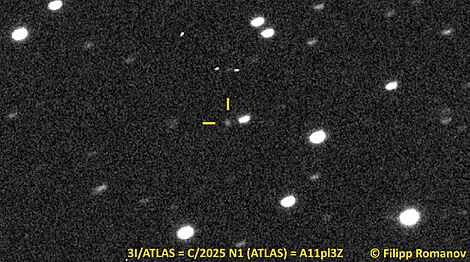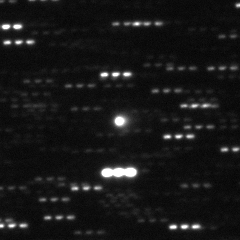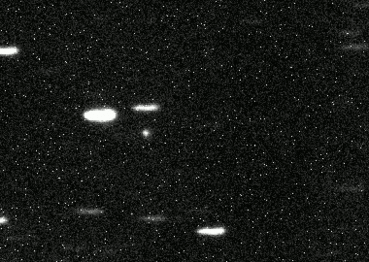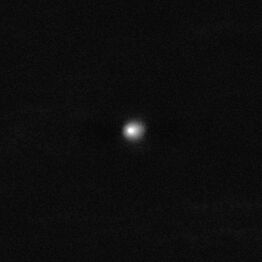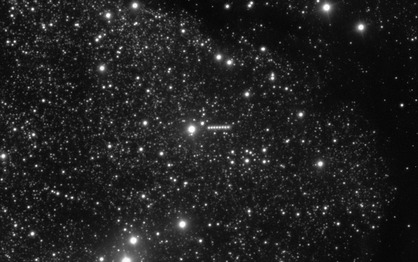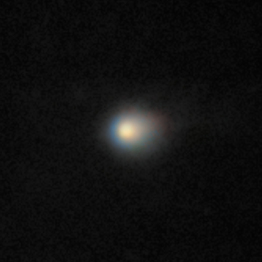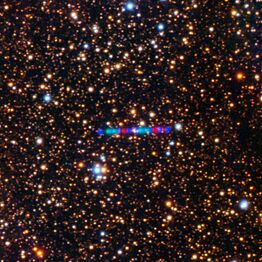3I/ATLAS facts for kids
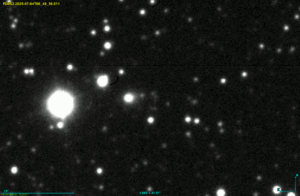
3I/ATLAS moving across a field of stars, as seen by the Very Large Telescope on 4 July 2025
|
|
| Discovery | |
|---|---|
| Discovery site | ATLAS–CHL (W68) |
| Discovery date | 1 July 2025 |
| Designations | |
| C/2025 N1 | |
| A11pl3Z | |
| Orbital characteristics | |
| Epoch | 7 July 2025 (JD 2460863.5) |
| Observation arc | 55 days (534 obs) |
| Earliest precovery date | 22 May 2025 |
| Orbit type | Hyperbolic (interstellar) |
| Perihelion | 1.357±0.0005 AU |
| Semi-major axis | −0.2638±0.0001 AU |
| Eccentricity | 6.144±0.004 |
| Max. orbital speed | 68.3 km/s @ perihelion = 58 km/s = 58 km/s |
| Inclination | 175.11±0.0003° (retrograde and inclined 5°) |
| 322.16±0.006° | |
| Argument of periapsis |
128.00±0.005° |
| Next perihelion | 29 October 2025 11:36 ± 00:11 UT |
| Earth MOID | 0.3658 AU |
| Mars MOID | 0.018 AU |
| Jupiter MOID | 0.2466 AU |
| Physical characteristics | |
|
Mean diameter
|
~4–5 km (2.5–3.1 mi) <23.6 km (14.7 mi) |
| Comet total magnitude (M1) |
8.8±0.7 |
3I/ATLAS is a special comet that came from outside our Solar System. It is also known as C/2025 N1 (ATLAS). It was found on July 1, 2025, by a telescope system called ATLAS in Chile.
When it was discovered, 3I/ATLAS was about 673 million kilometers (4.5 AU) from the Sun. It was moving very fast, at about 61 kilometers per second (38 miles per second). This comet is the third object confirmed to be visiting our Solar System from interstellar space. The first two were 1I/ʻOumuamua (found in 2017) and 2I/Borisov (found in 2019).
The exact size of 3I/ATLAS's center, called its nucleus, is not fully known. This is because it is an active comet. It is surrounded by a cloud of dust and gas called a coma. Scientists think its nucleus could be anywhere from 0.8 to 24 kilometers (0.5 to 15 miles) wide. However, it is probably closer to the smaller end of that range.
3I/ATLAS will get closest to the Sun on October 29, 2025. At that point, it will be about 203 million kilometers (1.357 AU) from the Sun. When it is far from the Sun, it will still be moving at about 58 kilometers per second (36 miles per second). Scientists believe this comet might be more than 7 billion years old. It may have come from a very old part of our Milky Way galaxy.
Contents
How 3I/ATLAS Was Found
Discovery of the Comet
3I/ATLAS was first seen on July 1, 2025. It was discovered by the NASA-funded ATLAS telescope in Chile. At the time, it looked like a faint object in the sky. It was moving quickly into the inner Solar System.
When it was first reported, scientists thought it might come very close to Earth. This made it an object of interest for the Minor Planet Center. However, more observations quickly showed that it would not come close to Earth. Instead, its path suggested it was an object from outside our Solar System.
Early Observations
Scientists looked at older telescope images to find "pre-discovery" observations of 3I/ATLAS. These images confirmed its path from interstellar space. Some of these older images were from May and June 2025. An amateur astronomer, Sam Deen, noticed that the comet might have been hard to spot earlier. This was because it was passing in front of a very crowded part of the sky.
At first, it was unclear if 3I/ATLAS was an asteroid or a comet. Some astronomers did not see any signs of a comet. But on July 2, 2025, other telescopes saw a faint coma and a short tail. This showed that it was indeed a comet. The Minor Planet Center then officially named it "3I," meaning it was the third confirmed interstellar object. They also gave it the comet name C/2025 N1 (ATLAS).
More Recent Views
After its discovery, many telescopes observed 3I/ATLAS. On July 2, 2025, the Nordic Optical Telescope confirmed it was "clearly active" with a tail. The Teide Observatory also saw a tail that was at least 25,000 kilometers (15,500 miles) long.
Measurements showed that the comet's coma had a reddish color. This is similar to the previous interstellar comet, 2I/Borisov. Scientists tried to figure out how fast the comet spins. However, the dust cloud around it made it hard to see its nucleus clearly.
More observations were published on July 6, 2025. These included older images from May and June. The Hubble Space Telescope is also scheduled to observe 3I/ATLAS on July 21, 2025. These images will be made public right away.
Comet's Journey Through Space
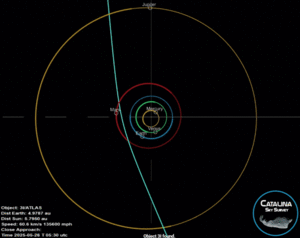
3I/ATLAS is on a path that will take it out of our Solar System forever. This type of path is called a hyperbolic trajectory. It has a very high orbital eccentricity of 6.144. This is the highest eccentricity of any interstellar object found so far.
The comet will reach its closest point to the Sun, called perihelion, on October 29, 2025. It will be about 203 million kilometers (1.357 AU) from the Sun. At this point, it will be moving at its fastest speed, about 68 kilometers per second (42 miles per second). When it is far from the Sun, its speed will be about 58 kilometers per second (36 miles per second).
The comet's path is tilted about 175 degrees compared to the ecliptic (the plane where most planets orbit). This means it is moving in the opposite direction to most planets. Scientists think it came from the "thick galactic disk," a part of our galaxy with many older stars.
Close Approaches to Planets
As 3I/ATLAS travels, it will pass by some of our Solar System's planets:
- It will pass about 29 million kilometers (0.194 AU) from Mars on October 3, 2025.
- After passing the Sun, it will pass about 269 million kilometers (1.798 AU) from Earth on December 19, 2025.
- Then, it will pass about 53 million kilometers (0.356 AU) from Jupiter on March 16, 2026.
When it passes Mars, the comet might be bright enough for spacecraft orbiting Mars to see it. However, from Earth, 3I/ATLAS will not be visible when it is closest to the Sun. This is because Earth and the comet will be on opposite sides of the Sun. The comet will become visible from Earth again in early December 2025.
Size and Brightness
Scientists estimate that the main part of 3I/ATLAS, its nucleus, could be up to 24 kilometers (15 miles) wide if it were a dark asteroid. However, because it is an active comet with a bright dust cloud (coma) around it, its actual nucleus is likely much smaller.
3I/ATLAS does not seem as active as the previous interstellar comet, 2I/Borisov. This suggests that 3I/ATLAS's nucleus might be about ten times larger than 2I/Borisov's. 2I/Borisov's nucleus was estimated to be between 0.4 and 0.5 kilometers (0.25 to 0.3 miles) wide. So, 3I/ATLAS's nucleus could be around 4 to 5 kilometers (2.5 to 3 miles) wide. But it is probably even smaller, possibly less than 1.2 kilometers (0.75 miles) wide.
The comet is not expected to get brighter than a certain level, around apparent magnitude 11.5. This means it will be too faint to see with average 50 mm binoculars. Also, from October 1 to November 9, 2025, the comet will be very close to the Sun in the sky. This will make it even harder to observe.
Gallery
1 July 2025
2 July 2025
-
Imaged remotely at Río Hurtado, Chile
3 July 2025
-
Imaged by ESO's Very Large Telescope
-
VLT FORS2 ESO image of 3I/ATLAS in motion through 13 minutes - visible as a line


